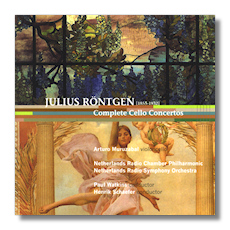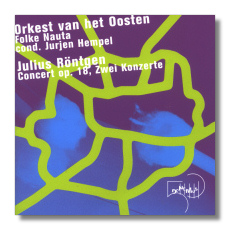
The Internet's Premier Classical Music Source
Related Links
- Latest Reviews
- More Reviews
-
By Composer
-
Collections
DVD & Blu-ray
Books
Concert Reviews
Articles/Interviews
Software
Audio
Search Amazon
Recommended Links
Site News
 CD Review
CD Review
Julius Röntgen

Complete Cello Concertos
- Concerto for Cello #1 in E minor
- Concerto for Cello #2 in G minor
- Concerto for Cello #3 in F Sharp minor *
Arturo Muruzabal, cello Netherlands Radio Chamber Philharmonic Orchestra/Paul Watkins * Netherlands Radio Symphony Orchestra/Henril Schaefer Etcetera KTC1329


Piano Concertos
- Concert D Dur fur Pianoforte und Orchester, Op. 18 (1879)
- Zwei Konzerte for Klavier und Orchester (1929-1930)
Folke Nauta, piano
Orkest van het Oosten/Jurjen Hempel
Donemus CV64
Cello concertos in the active repertoire are few in number. Not as few as viola concerti, to be sure, but too many, including many that Rostropovich commissioned, languish in obscurity. The second concerto presented here was written for Pablo Casals. And any of these three by Röntgen would enliven concert programs.
All of Röntgen's cello concertos begin in minor keys and end in major keys. The first is in the usual three movements but does not pause between movements; the others are each in a single movement. #1, in E minor dates from 1893-1894; #2, in G minor, from 1909; and #3, in F# minor, came toward the close of Roentgen's long career, in 1928.
The notes – in four languages – speak of the 15-minute opening movement of the first concerto in terms of drama and conflict, and there are indeed some great slashing chords from the orchestra, in the spirit of Beethoven, perhaps, but modern ears may be more struck by its lyrical, soaring melody. There is no tempo specified. The cadenza is more gentle than not and the ending is songful, even though with vigorous orchestral comments. In general the orchestra plays together with no instruments standing out.
The all too short slow movement (6:17) begins quietly with a high sustained note, over the sound of the horn (heard later in the movement also) and some staccato playing. When the cello enters – after a minute – there is a pizzicato accompaniment. There is just a moment halfway that reminded me of the thumps which begin the third act of La Bohème. There is some high legato phrasing and strong bowing from the soloist.
The finale is fast, vigorous and exuberant. Attacks are varied: staccato, pizzicato, and sustained notes. Woodwinds are heard and the full orchestra is permitted to take the melody.
The second cello concerto begins with broad phrasing for the cello and I can imagine Casals playing this. It is a good two minutes before the orchestra enters. When it does arrive, it is with great vigor, with brass and thumping chords. Five minutes in, a gentle melody is lightly accompanied and sustained for a couple of minutes; this shifts to a lighter – maybe too light – and faster, skipping, syncopated passage with triangle. There is also a passage reminiscent of Röntgen's friend and conservatory classmate, Grieg. The later parts of the concerto take things much more seriously, with loud, heavily orchestrated treatment and an almost Mahlerian brass fanfare at one point, as well as a passage I found harmonically interesting. The woodwinds are given some exposure and the ending of the concerto is exultant.
Cello Concerto #3, only a little over sixteen minutes, wastes no time in introducing both the orchestra and the soloist and there is quite a lot of variety in the use of both: some four-square rhythm, some rather angular phrasing from the cello, declamatory orchestra with the cello responding, in more than one place. The flute is given a rather Grieg-like passage, with quiet phrases that really breathe. There are some long, rising, melodic lines; the flute and bassoon interact, and at one point the cello seems to talk with the woodwind. Halfway through there is a trill and a light drum roll introducing an assertive orchestra and a vigorous cello. Toward the end, the orchestra takes the melody and a vigorous tutti with drums introduces a very substantial cadenza, following which the concerto ends quickly.
Although clearly tonal, the cello concertos strike me, for the most part, although written over a period of a quarter century, as almost timeless. Aside from the specific references I made, especially to Grieg, I am not really inclined to place them is a neat stylistic frame. Certainly they are in no way modern, but their mood – more gentle than not, in spite of some vigorous moments, would not be jarring to the ears of either Schumann or Elgar.
The three piano concertos recorded here (he wrote seven), in contrast, are unmistakably Romantic. Written over an even longer period than the cello concertos, the first especially, shows the influence of Brahms, who happened to be one of Röntgen's best friends. Interestingly, though, Röntgen did not even like the music of Brahms, especially the latter's first piano concerto, until shortly before he wrote the first of these two concertos. This was in 1879, a year after he had take up residence in Amsterdam, where he spent the bulk of his career.
Röntgen's D Major concerto, the only one of his piano concerti published in his lifetime, begins gently, is certainly more lyrical than dramatic, and is very pleasurable to listen to. The second movement, Larghetto espressivo, is also gentle, with a second theme that for a time becomes a waltz. There is nice use of the horn and woodwind, though the orchestration is mostly for strings. The finale, Allegro con brio, is quite Brahmsian and features the brass at the end.
The two concertos from 1929-1930 are presented as a pair. The excellent notes by Theo Muller compare the rhapsodic structure and thematic treatment of the sixteen minute first concerto to Franck, Bizet, Tchaikovsky, Rimsky Korsakoff, and Reger. The mood ranges from gentle to loud and vigorous. The tempo is unspecified. The second concerto is in three movements but, Muller notes, the first movement sounds like a finale for the first concerto; no tempo is specified there either, but it is played fast. The slow movement following I find quite lovely. It opens with a cello solo and has some nice writing for the flute and bassoon as well as the piano. The fast finale is strongly rhythmic.
Copyright © 2007, R. James Tobin



















